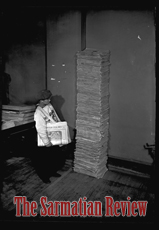| This Issue | Back Issues | Editorial Board | Contact Information |

Community and Identity in American Polonia
John M. Grondelski
By William J. Galush. Boulder, CO: Eastern European Monographs distributed by Columbia University Press, 2006. 312 + xi pages. Index. ISBN 0-88033-587-4. Hardbound. $40.00.
Polish Americans refer to the Great Immigration of Poles to the United States between 1880 and 1920 as emigracja za chlebem, or economic emigration. They thus distinguish these economic migrants from post-World War II political refugees, or emigracja polityczna. Fleeing a lack of economic opportunity in a partitioned Poland, the economic migrants provided the backbone for America's urban industrialization.
One of American Polonia's achievements was to forge a common Polonian identity on foreign shores from among disparate groups of Pomeranians, Mazovians, and Galicians that came from partitioned Poland.
While the emigracja za chlebem may have been economically motivated, Galush's book shows that Polonia did not live on bread alone. Galush is professor of history emeritus at Loyola University in Chicago. His monograph examines how those Polish immigrants created and developed communities built on competing visions of Polishness (polskość) in four localities: Cleveland, Ohio; Minneapolis, Minnesota; Utica, New York; and New York Mills, New York. His work generally agrees with other recent research (e.g., Karen Majewski's Traitors and True Poles [2003]), and it encourages scholars to revisit the intellectual and cultural history of these immigrants. They may have been limited in terms of formal educational attainment, but it does not follow that they neither thought nor read. Far from being Stanley Kowalski-like “dumb Polacks”-short on brain but long on brawn-the emigracja za chlebem was sufficiently ethnically and ethically conscious that its contemporary elite was able to forge a common Polish identity on foreign shores from among disparate groups of Pomeranians, Mazovians, and Galicians that came from partitioned Poland.
Galush studies how that Polonia constructed community in a variety of contexts, but primarily parishes, fraternal organizations, and schools. He also observes the process of forging a Polonian identity, neither completely Polish nor totally assimilated American, but a blend of both. He probes how the First World War constituted a watershed moment for Polonia: on the one hand, the old country's independence was imminent; on the other, pressures on immigrants to “Americanize” were never greater. He also studies how the generation of immigrants' children acquired a separate Polonian identity, one that distanced itself from now-independent Poland and one that would reshape the cultural and institutional life of Polonia as it then existed.
What particularly commends this study is its focus on four relatively small Polonian communities, two in the Rust Belt and two in New York State mill towns. Monographs on the emigracja za chlebem tend to focus on Chicago or larger metropolitan areas to the neglect of other Polonian communities (although James S. Pula has written comprehensively on the Polonia of New York Mills). Galush overcomes that bias, and his attention to Polonia in the mill towns should stimulate yet-nonexistent research on Polonian settlements in New England.
This book does not arrive at new and radical generalizations or conclusions. Its value lies in the details of field research. It seeks to probe the fabric of Polonian communities. For example, in his discussion of the Polonian parish in chapter 4, Galush sensitively discusses the delicate interplay of clerical and lay influences in a specific parish. While conceding that pastors needed to “persuade as well as command,” Galush acknowledges that contemporary sacerdotal self-image “encouraged an authoritarian style.” Galush's particular contribution is acknowledging that factors unique to America impacted clerical leadership styles. On the one hand, parishes were often launched as lay initiatives, sometimes including the recruitment of a priest. On the other hand, Polish clergy in America were not constrained by wealthy szlachta benefactors and instead benefited from the emphasis in American Catholicism on “clerical dignity” (71). Galush pays attention to the mediating role of Polonia's clergy, acculturating Polish Catholics to the Catholic Church in America while simultaneously defending the interests of their parishioners vis-a-vis diocesan bishops and chanceries who regarded a successful ethnic parish as sooner or later doomed to extinction.
Galush's treatment of education in chapter 5 tells us more about Polonia through its details than its broader conclusions. Parochial schools were founded because immigrants wanted their children to obtain a religiously-based education. But they also emerged because parochial schools were encouraged by the American Catholic Church, eager to shield young people from Protestant-influenced public schools. Galush argues that parochial schools often had to compete with public schools: immigrants were tempted by free public education. He also suggests another factor: kindergartens existed in Austrian and Prussian Poland and in American public schools, but sometimes not in Polish parochial schools (101). This additionally tempted parents familiar with†such kindergartens in the old country to opt for public schools.
New gender roles, economic assimilation and success by the first generation born in America, as well as changing styles of leadership are further examined by this book. All in all, Galush provides insights into the dynamic and community life of nineteenth- and twentieth-century American Polonia. While some critics have contended that this book does not offer sufficient generalizations and analysis, in my opinion such criticism misses the mark. The significance of this book should be sought in the data it provides. Polonia still needs basic field research, such as represented by Galush's book, before it begins to theorize itself.
Back to the April 2008 Issue
The Sarmatian Review
sarmatia@rice.edu
Last updated 4/22/08